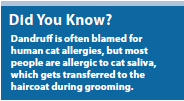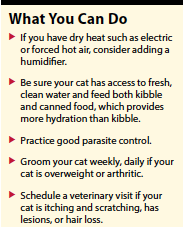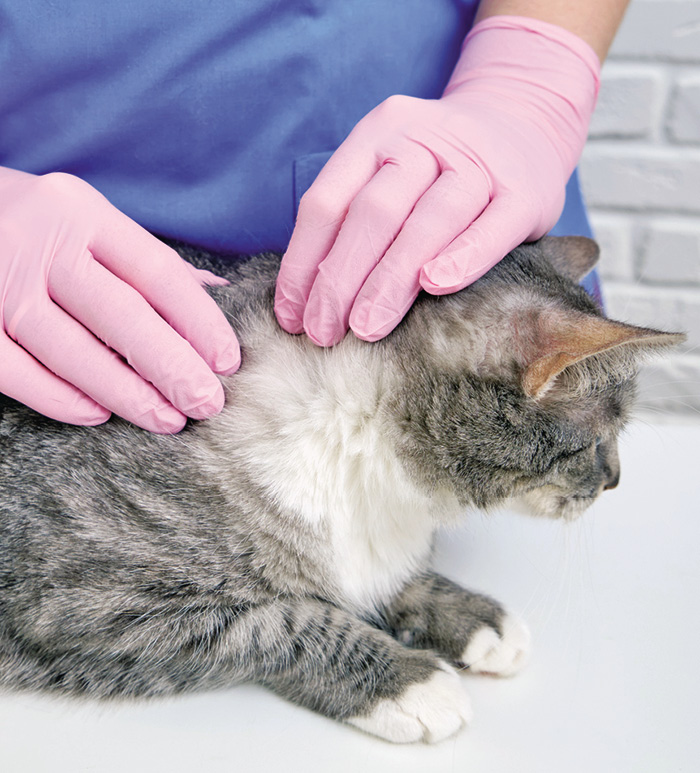You run your hand over your normally sleek, shiny cat and notice flakes of dry skin. Her coat looks a bit dull, too, and it appears that she has suddenly developed dandruff. Not really. Dandruff is the normal shedding of dead skin cells, an ongoing process even in healthy cats.
“People have to remember that all animals produce dandruff 24/7/365. Normally, the flakes are so small that they aren’t recognized by the naked eye. With cats, their daily grooming typically removes any that might rise to the surface of the coat. When you’re talking dandruff, you have to determine if the cat is itchy and if itching came first or whether the dandruff was spontaneous. If itching—even signs of mild itching like overgrooming—came first, then you have tons of things to consider. External parasites, fleas, and cheyletiella mites, especially, are No. 1, but it could be generalized ringworm, allergies, etc.,” says William H. Miller Jr VMD, Professor Emeritus of Dermatology, Cornell University’s College of Veterinary Medicine.
Dandruff can be associated with dry skin or oily skin. Causes and treatments will vary with the type of dandruff.
Dry Skin Dandruff
Dry skin can result from environmental conditions such as heating units in your house in winter, which can result in low humidity. Adding a humidifier and regular grooming will help stimulate normal skin oils, and that may be all that is needed.
Dry skin can also result from a poor diet or poor hydration. You need to feed a food that is complete and balanced, which means the food has been formulated to meet AAFCO (American Association of Feed Control Officials) standards for your cat’s age. The AAFCO certification on pet foods is normally printed on the label.
You can help with hydration by adding some water to her food or by feeding canned food in addition to kibble. Make sure her diet has adequate omega fatty acids, as these are important for skin health.
Dr. Miller cautions that cats on a low-fat diet will often develop dandruff. Extreme weight loss diets can do the same thing. If your cat is on a prescription low-fat diet, an omega-3 fatty acid supplement like fish oil may help, but consult your veterinarian.
Oily Skin Dandruff
Oily skin with flakes indicates seborrhea. Seborrhea is a condition in which the sebaceous skin glands produce more sebum (oily secretions) than normal. This often results in flakes of dandruff seen along the back of your cat. You may also notice skin flakes building up on her bedding and in spots where she likes to sleep. Some owners also notice an odor.
 Primary seborrhea can be inherited and is seen in some cat breeds such as Persians. More commonly, seborrhea and dandruff are secondary to another health problem such as allergies, parasites, metabolic diseases such as hyperthyroidism, or a poor diet, especially one that lacks sufficient omega-3 fatty acids. Obesity and arthritis may contribute to seborrhea if your cat has trouble grooming, allowing oils and shed skin cells to build up. Fungal and bacterial skin infections may also contribute to dandruff.
Primary seborrhea can be inherited and is seen in some cat breeds such as Persians. More commonly, seborrhea and dandruff are secondary to another health problem such as allergies, parasites, metabolic diseases such as hyperthyroidism, or a poor diet, especially one that lacks sufficient omega-3 fatty acids. Obesity and arthritis may contribute to seborrhea if your cat has trouble grooming, allowing oils and shed skin cells to build up. Fungal and bacterial skin infections may also contribute to dandruff.
More Than Dandruff
If you notice itching, skin lesions, or hair loss with the dandruff, you need a veterinary evaluation. Your veterinarian will do skin scrapes, possibly a fungal or bacterial culture, and a thorough exam for parasites. Bloodwork to evaluate your cat’s overall health may also be recommended.
If an underlying cause is identified, that needs to be cleared first. “Get rid of the primary disease and the dandruff will go away by itself,” says Dr. Miller. For parasites, your cat and any other animals in the house will need to be treated. Fungal and bacterial infections may require oral medications such as antibiotics or antifungals (the latter may also be topical if lesions are localized). Metabolic diseases such as hyperthyroidism or Cushing’s disease will require specific therapy.
A mousse or shampoo program may be prescribed by your veterinarian. “There are lots of shampoos, but most cats fail to see the sense of humor in getting a bath. With all the disorders that result in dandruff, the dandruff won’t go away with one bath. Bathing once to twice weekly typically is needed for 30 to 45 days. If the cat will allow that, then a mild grooming shampoo should do the trick. Medicated shampoos should only be used if they are prescribed by a veterinarian,” says Dr. Miller.





